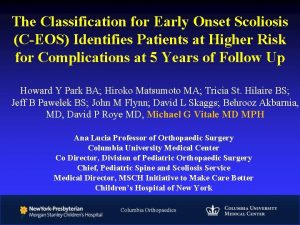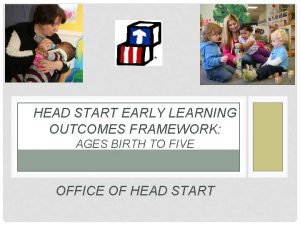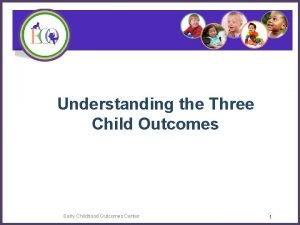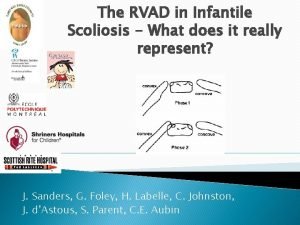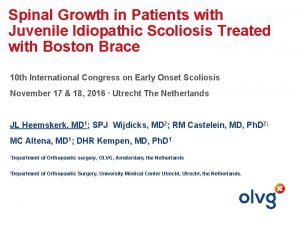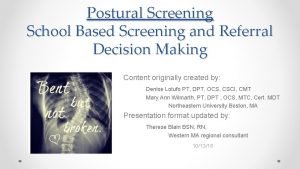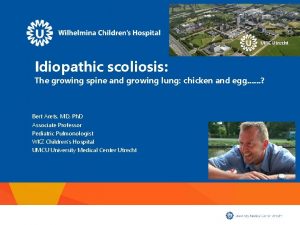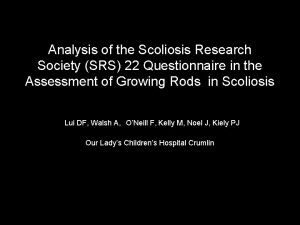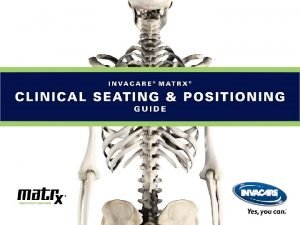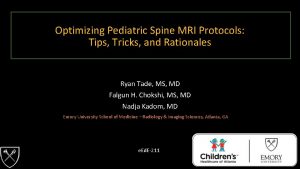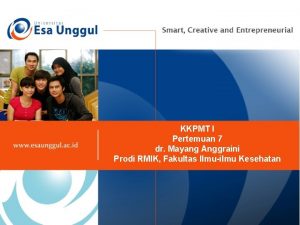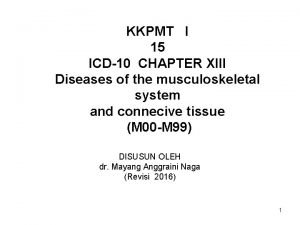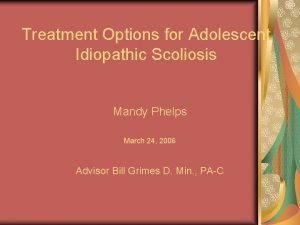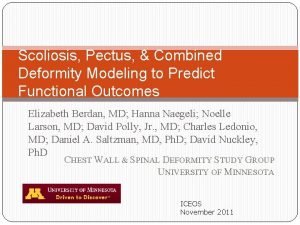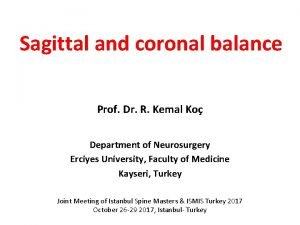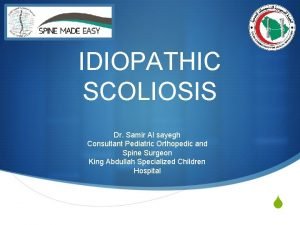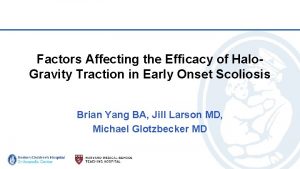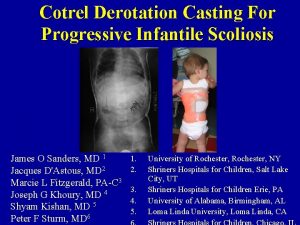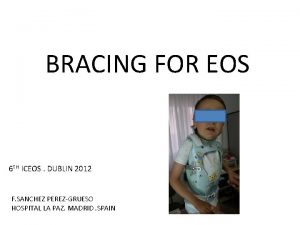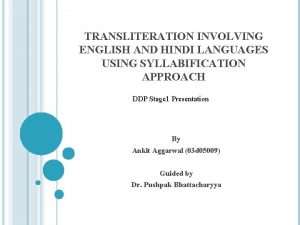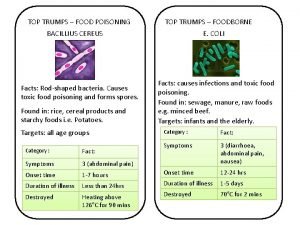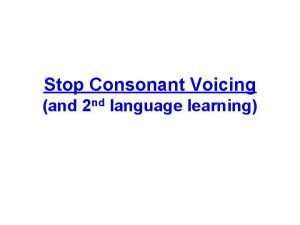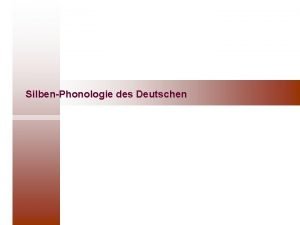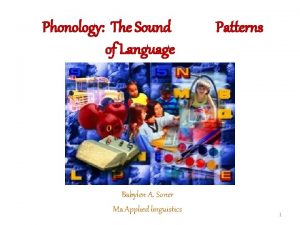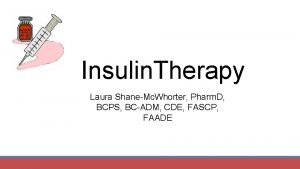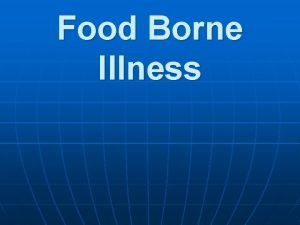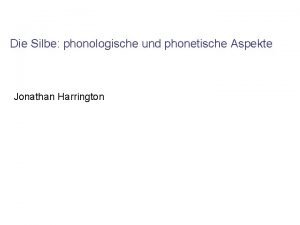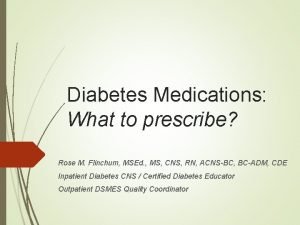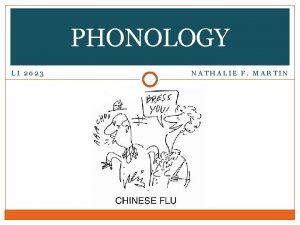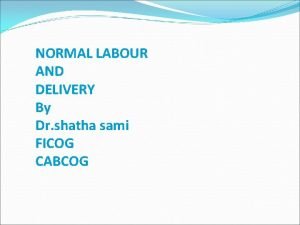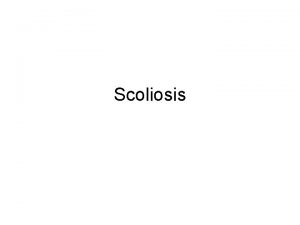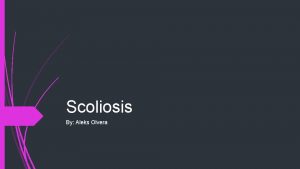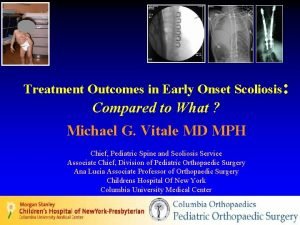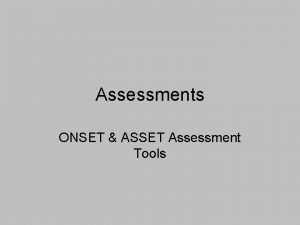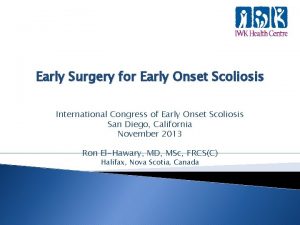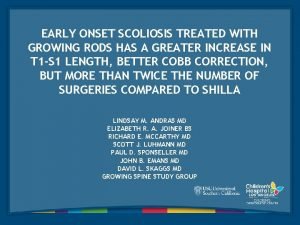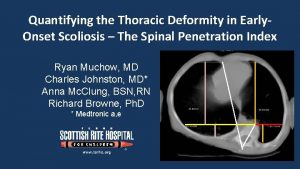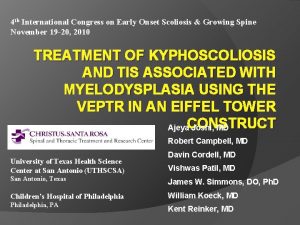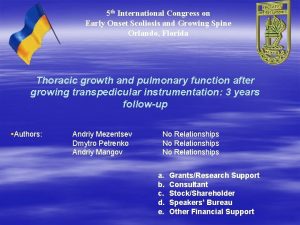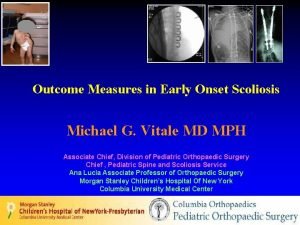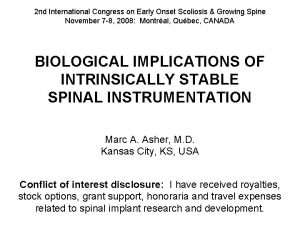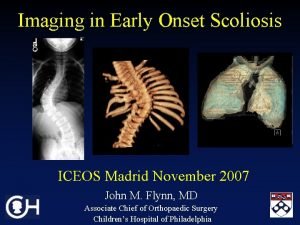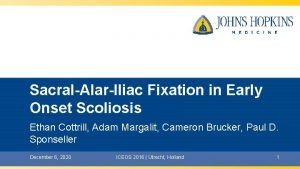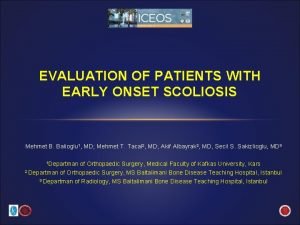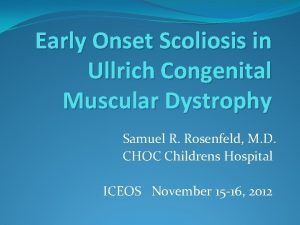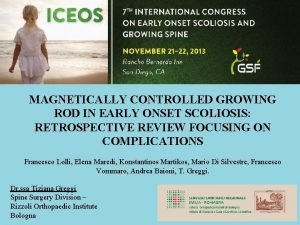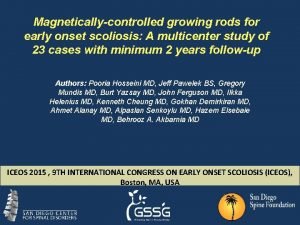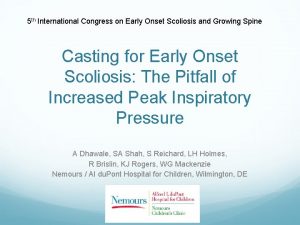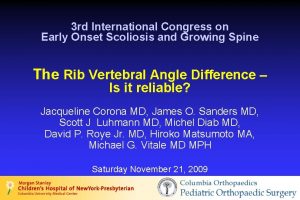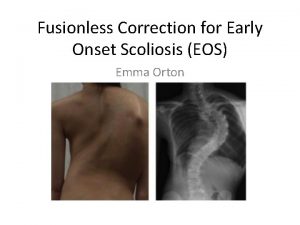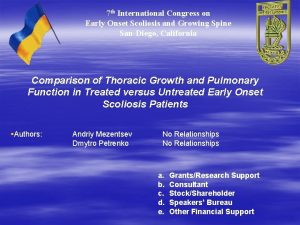Quality of Life Outcomes in Early Onset Scoliosis







































- Slides: 39

Quality of Life Outcomes in Early Onset Scoliosis Michael Vitale, MD MPH Ana Lucia Associate Professor of Orthopaedic Surgery Chief Pediatric Spine and Scoliosis Service Morgan Stanley Children’s Hospital of New York

Why Assess Quality of Life ? • Realization that “technical”, “traditional” endpoints have shortcomings • Different, but better ? • QOL may be the best endpoint to use when assessing the effect we have on our patients

Patient-Based Outcomes • “ In the field of scoliosis, there is one rule: keep your eye upon the patient, and not upon the curve. ” -Cobb, 1948 • “Treat the patient, not the x-rays. ” - Blount, 1955

OUTCOMES: Why Treat Children With Scoliosis? • To decrease curve/stop progression curve… – decrease pain or increase function ? – for psychosocial reasons ? – for cosmetic reasons/self image ? – To improve lung function ? • To prevent future progression and future disability • Will QOL measures respond to any of the above?

“Quality of Life”

Health Related Quality of Life (HRQL) Physical Function Pain Psychosocial Fx • Self Image • Role Function • Emotional Hlth Psych Fx Physical Fx • ROM • Alignment • Mobility • ADL • Sports

Disease-Specific and Generic Measures Are Complementary and Both Necessary Disease- specific Impact Clinical Markers eg -Cobb Angle - Decompensation -Space avail lung Specific symptoms • Physical Limits • Social • Role Function Global Impact • functional status • well-being • psychosocial function • vitality -School eg - TIS -ADL Work/ Family Health-Related QOL Adapted from Ware, AAOS, (2001)

Intrinsic Difficulties in Pediatric Quality of Life Assessment • Developmental issues -> need for age-based norms • Often need to use parent as proxy- VALID ? • Many procedures in pediatrics are “prophylactic” – i. e. intended to prevent future disability…scoliosis • Long periods of follow up needed • Natural history of disease unclear

Psychometrics “the science of measurement” • Score Distribution • Validity (criterion, concurrent, face, discriminant) • Reliability / Reproducibility • Responsiveness

Score Distribution • Ceiling Effects – All patients score near top of scale • Floor Effects – All patients score near bottom of scale

SF-36 : Ceiling Effects in AIS • “Fatal” ceiling effects – i. e. too many patients scored at high end of scale despite evidence for clinical differences between patients Quality of Life in Adolescent Orthopaedic Patients: Are Adult Measures Appropriate? Vitale et al, 2001

Who are your patients ? Sports without Limitations Vigorous activities with limitations Moderate activities with limitations Walk slowly Trouble bending, stooping Need help to bathe Cannot maintain balance Move about with help Stand up with help Staying in bed/partly undressed Lying down most of time Confined to room, bed

Validity Does it measure what it is intended to measure? • Concurrent / Criterion Validity – What is correlation with “ Gold Standard ? ” • Discriminant Validity – Does the instrument discriminate among patients with different degrees of severity ?

Reliability Is it free from random error ? • Internal consistency – do items on the same scale vary with each other ? – Cronbachs alpha • Reproducibility- test/retest comparison – Intraclass Correlation Coefficient

Responsiveness Is it sensitive to change over time / treatment ? • Does the instrument reflect changes in disease status ? • Pre Vs Post Op

QOL is affected in Adult Patients with Scoliosis • Schwab et al; Spine 03 Adult scoliosis patients have lower SF-36 scores • Albert et al; Spine ‘ 95 - SF-36 scores improved in adults after scoliosis surgery • Danielsson et al, Spine ‘ 01 - Lower physical function, not mental health scores regardless of treatment or curve size

QOL in AIS: Vitale et al, JPO 2003 QOL Before and After Scoliosis Surgery • • 40 patients followed longitudinally Min follow-up: 12 months Average # of spinal levels fused: 10 Average degree of curvature: – Preop: 54 degrees – Postop: 22 degrees • CHQ , PODCI, SRS Measure

Newer Pediatric Measures : CHQ • Child Health Questionnaire (CHQ) – Landgraf and Ware ’ 90. Released 1/97 – Versions: PF 98/ PF 50/ PF 28/ CF 87 – age-adjusted normative values available – extensively validated

Newer Pediatric Measures: PODCI • AAOS PODCI: Pediatric Outcomes Data Collection Instrument – “population specific” for pediatric orthopaedics – Separate child and parent forms – 108 q – Norms available

Newer Pediatric Measures: SRS • Haher et al, Spine 1995 – Meta-analysis of Surgical Outcomes in AIS: 2926 patients – Need for standardized measure of patient outcome • Haher et al, Spine August 1999 Scoliosis Research Society Instrument (SRS) 24 items; 7 domains – Good initial validity and responsiveness

CHQ : Children with Scoliosis Have Lower Physical Scores than Norms Vitale et al, JPO, 2003

Psychosocial Scores Some Differences in “Family Health” Vitale et al, JPO, 2003

PODCI: Before and After Surgery

SRS: Before and After Surgery

HRQOL in AIS • Appropriate measures pick up some differences in self-reported health status – Pain, physical health, self image, family fx • Expectations met (PODCI) and satisfaction high (SRS) • Curve size does NOT seem to correlate with QOL

What are the quality of life issues in early onset scoliosis ? • What is QOL in patients at baseline – ? effect of curve size, onset, comorbidities • What is effect of treatment – Early fusion – Repetitive Surgery

Comorbidities and EOS • Children with early onset scoliosis often have significant comorbidities and can rapidly develop thoracic insufficiency and pulmonary compromise. • The effect of thoracic insufficiency, early onset scoliosis and associated problems can significantly effect the quality of life of these children

Early Spine Fusion is Associated with Adverse Pulmonary Outcome • Respiratory function and cosmesis at maturity in infantile-onset scoliosis. Spine. 2003; 28: 2397 -406. – Goldberg CJ, et al. • Earlier and More Extensive Thoracic Fusion is Associated with Diminished Pulmonary Function: Outcomes after Spinal Fusion of 4 or more Thoracic Spinal Segments Before Age 5. Poster presentation, IMAST, Bermuda, 2004. – Emans JB, et al. • The effect of early thoracic fusion on pulmonary function in nonneuromuscular scoliosis, SRS , Miami, 2005 – Karol, L. et al. • PFT and QOL after Early Fusion; POSNA, Ft Lauderdale, 2007 – Vitale et al

Retrospective Cohort Study of Pulmonary Function, Radiographic Measures and Quality of Life in Children with Congenital Scoliosis: An Evaluation of Patient Outcomes after Early Fusion Vitale et al, 2006 • 7 year follow up on 27 patients with early fusion (6 yrs avg) for congenital scoliosis • Poor PFT, Poor QOL • Age at fusion and residual curve at follow up seems to strongly drive lung function • Quality of life appears to be largely independent of Cobb, age and other factors

Health Related Quality of Life in Children with Thoracic Insufficiency Syndrome • Retrospective database review of original multi-center evaluation of the VEPTR – Child Health Questionnaire Parent Form (CHQ) – Age > 5 years • 3 diagnostic categories: – Rib Fusion (RF, N=15) – Hypoplastic Thorax Syndrome (HT, N=17) – Progressive Spinal Deformity (PS, N=13)

Physical Functioning Role/Social Limitations - Physical Large Differences in Physical Aspects of Quality of Life

Parental Impact Emotional Parental Impact. Time The Impact of Caring For a Child with TIS on the Family is Profound

Conclusions: QOL in TIS • These scores are among the lowest observed in pediatrics – Asthma – JRA – Heart transplant

Conclusions: QOL in TIS • Patients with thoracic insufficiency syndrome have significant and profound perturbations in QOL when compared with other children • Much different than AIS

Traditional Endpoints and Patient Based Measures Dont Necessarily Correlate Curve QOL Satisfaction Separate Analyses are required

Towards a Disease Specific Measure Sports without Limitations Vigorous activities with limitations • We need a better ruler to examine HRQOL and responsiveness in EOS Moderate activities with limitations Walk slowly Trouble bending, stooping Need help to bathe Cannot maintain balance • “What is the QOL effect of Repetitive Surgery” Move about with help Stand up with help Staying in bed/partly undressed Lying down most of time Confined to room, bed

“Bad QOL” “Bad Lungs” “Crooked Spine”

Conclusions • EOS is bad disease • QOL is ONE important outcome measure • We need both disease specific measures and generic QOL measures

mgv 1@columbia. edu
 Early onset scoliosis classification
Early onset scoliosis classification Headstart early learning outcomes framework
Headstart early learning outcomes framework Early childhood outcomes examples
Early childhood outcomes examples Early childhood outcomes center
Early childhood outcomes center Ancient rome outcomes geography and early republic
Ancient rome outcomes geography and early republic Missouri quality outcomes
Missouri quality outcomes Rvad
Rvad Scoliosis chiropractor seminole county
Scoliosis chiropractor seminole county Risser stage
Risser stage Scoliosis
Scoliosis Scoliosis research society
Scoliosis research society Hyperextesion
Hyperextesion Mri scoliosis protocol
Mri scoliosis protocol Thoracogenic scoliosis of thoracolumbar region
Thoracogenic scoliosis of thoracolumbar region Disorder of synovium and tendon
Disorder of synovium and tendon Infantile scoliosis casting
Infantile scoliosis casting Scoliosis advisor
Scoliosis advisor Rib hump scoliosis
Rib hump scoliosis Horizontal
Horizontal Dr abdullah sayegh
Dr abdullah sayegh Halo gravity traction
Halo gravity traction Derotation cast
Derotation cast Turnbuckle cast scoliosis
Turnbuckle cast scoliosis English life skills stage 6
English life skills stage 6 Early cpr and early defibrillation can: *
Early cpr and early defibrillation can: * Lektat
Lektat Consonat clusters
Consonat clusters Food top trumps
Food top trumps Voice onset time
Voice onset time Silbenanlaut
Silbenanlaut Assimilation of voice examples
Assimilation of voice examples Questions about phonology
Questions about phonology Voice onset time
Voice onset time Continuous subcutaneous insulin infusion
Continuous subcutaneous insulin infusion Food poisoning onset
Food poisoning onset Anaphylaxis onset
Anaphylaxis onset Onset reim
Onset reim Nph onset and peak
Nph onset and peak Onset coda and nucleus
Onset coda and nucleus Normal labour
Normal labour
